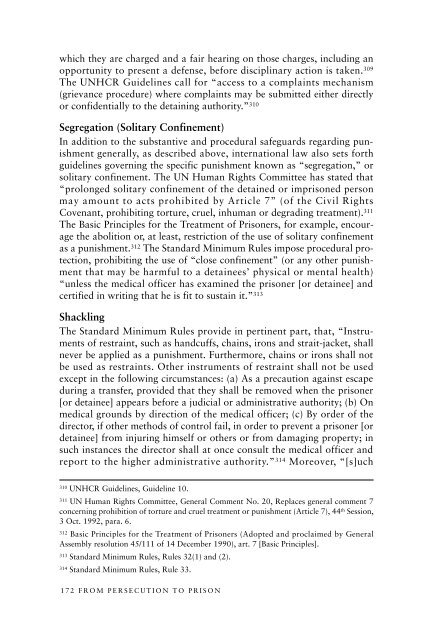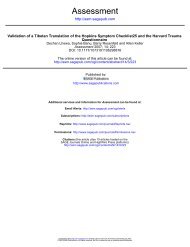From Persecution to Prison - Bellevue/NYU Program for Survivors of ...
From Persecution to Prison - Bellevue/NYU Program for Survivors of ...
From Persecution to Prison - Bellevue/NYU Program for Survivors of ...
Create successful ePaper yourself
Turn your PDF publications into a flip-book with our unique Google optimized e-Paper software.
which they are charged and a fair hearing on those charges, including anopportunity <strong>to</strong> present a defense, be<strong>for</strong>e disciplinary action is taken. 309The UNHCR Guidelines call <strong>for</strong> “access <strong>to</strong> a complaints mechanism(grievance procedure) where complaints may be submitted either directlyor confidentially <strong>to</strong> the detaining authority.” 310Segregation (Solitary Confinement)In addition <strong>to</strong> the substantive and procedural safeguards regarding punishmentgenerally, as described above, international law also sets <strong>for</strong>thguidelines governing the specific punishment known as “segregation,” orsolitary confinement. The UN Human Rights Committee has stated that“prolonged solitary confinement <strong>of</strong> the detained or imprisoned personmay amount <strong>to</strong> acts prohibited by Article 7” (<strong>of</strong> the Civil RightsCovenant, prohibiting <strong>to</strong>rture, cruel, inhuman or degrading treatment). 311The Basic Principles <strong>for</strong> the Treatment <strong>of</strong> <strong>Prison</strong>ers, <strong>for</strong> example, encouragethe abolition or, at least, restriction <strong>of</strong> the use <strong>of</strong> solitary confinementas a punishment. 312 The Standard Minimum Rules impose procedural protection,prohibiting the use <strong>of</strong> “close confinement” (or any other punishmentthat may be harmful <strong>to</strong> a detainees’ physical or mental health)“unless the medical <strong>of</strong>ficer has examined the prisoner [or detainee] andcertified in writing that he is fit <strong>to</strong> sustain it.” 313ShacklingThe Standard Minimum Rules provide in pertinent part, that, “Instruments<strong>of</strong> restraint, such as handcuffs, chains, irons and strait-jacket, shallnever be applied as a punishment. Furthermore, chains or irons shall notbe used as restraints. Other instruments <strong>of</strong> restraint shall not be usedexcept in the following circumstances: (a) As a precaution against escapeduring a transfer, provided that they shall be removed when the prisoner[or detainee] appears be<strong>for</strong>e a judicial or administrative authority; (b) Onmedical grounds by direction <strong>of</strong> the medical <strong>of</strong>ficer; (c) By order <strong>of</strong> thedirec<strong>to</strong>r, if other methods <strong>of</strong> control fail, in order <strong>to</strong> prevent a prisoner [ordetainee] from injuring himself or others or from damaging property; insuch instances the direc<strong>to</strong>r shall at once consult the medical <strong>of</strong>ficer andreport <strong>to</strong> the higher administrative authority.” 314 Moreover, “[s]uch310UNHCR Guidelines, Guideline 10.311UN Human Rights Committee, General Comment No. 20, Replaces general comment 7concerning prohibition <strong>of</strong> <strong>to</strong>rture and cruel treatment or punishment (Article 7), 44 th Session,3 Oct. 1992, para. 6.312Basic Principles <strong>for</strong> the Treatment <strong>of</strong> <strong>Prison</strong>ers (Adopted and proclaimed by GeneralAssembly resolution 45/111 <strong>of</strong> 14 December 1990), art. 7 [Basic Principles].313Standard Minimum Rules, Rules 32(1) and (2).314Standard Minimum Rules, Rule 33.172 FROM PERSECUTION TO PRISON



